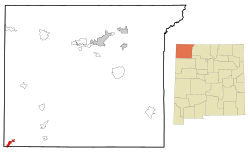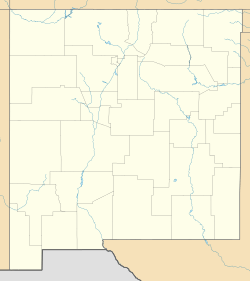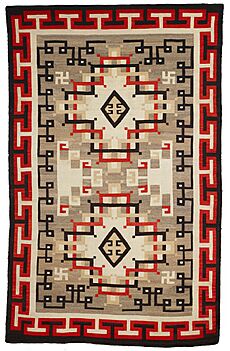Crystal, New Mexico facts for kids
Quick facts for kids
Crystal, New Mexico
|
|
|---|---|

Location in San Juan County and the state of New Mexico
|
|
| Country | United States |
| State | New Mexico |
| Counties | San Juan, McKinley |
| Area | |
| • Total | 4.57 sq mi (11.83 km2) |
| • Land | 4.55 sq mi (11.78 km2) |
| • Water | 0.02 sq mi (0.05 km2) |
| Elevation | 7,526 ft (2,294 m) |
| Population
(2020)
|
|
| • Total | 302 |
| • Density | 66.37/sq mi (25.63/km2) |
| Time zone | UTC-7 (Mountain (MST)) |
| • Summer (DST) | UTC-6 (MDT) |
| ZIP code |
87328 (Navajo)
|
| Area code(s) | 505 |
| FIPS code | 35-19080 |
| GNIS feature ID | 2407690 |
Crystal (Navajo: Tóniłtsʼílí) is a small community in New Mexico, United States. It is also known as a census-designated place (CDP). Crystal is located on the Navajo Nation and is part of both San Juan and McKinley counties. In 2020, 302 people lived here.
Crystal sits at the base of the Chuska Mountains. It is found at the western end of Narbona Pass. A post office served Crystal from 1903 to 1941.
Contents
History of Crystal
The first known trader in the Narbona Pass area was Romulo Martinez. He was a Spanish-American from Fort Defiance. This was in 1873. Other traders came and went in the following years. They often traded from tents during the summer.
Crystal was officially started in 1884. This is when a trading post was built there. The name "Crystal" probably comes from its Navajo name. This name means "crystal water flows out."
John Bradford Moore and the Trading Post
In 1896, John Bradford Moore arrived. He was an Irishman from Sheridan, Wyoming. He bought the trading site. Then, he cut timber from the mountains. He used this timber to build a log trading post. He filled it with supplies brought from the railroad in Gallup.
Moore named his post the Crystal Trading Post. It was at the western entrance of Narbona Pass. During the winter, he hired Navajo weavers. They made beautiful rugs. Moore made sure the wool and weaving were high quality. He also created his own rug designs. Soon, his post became known for excellent rugs.
Moore understood what people in the eastern United States wanted. His catalog highlighted natural materials and old weaving methods. However, he also used modern ways to make rugs. He was fine with using machine-made yarns and artificial dyes. Traders needed to keep costs low to sell rugs at good prices. This meant weavers were not paid much. Moore once said that weaving was a very low-paying job. He noted it was often the only way for weavers to earn money.
Moore left the trading post in 1911. His manager, A. J. Molohon, took over. The C.C. Manning company owned the Crystal Trading Post from 1919 to 1922. Later, Charlie Newcomb and then Jim Collyer owned it. In 1944, Don Jensen bought the post. He owned it until 1981. Jensen is thought to have helped create the modern Crystal rug style.
Geography of Crystal
Crystal is mostly in southwestern San Juan County. A small part of it is in the northwest corner of McKinley County. New Mexico State Road 134 ends in Crystal. This road goes northeast over Narbona Pass. It is about 17 miles (27 km) to U.S. Route 491 at Sheep Springs.
The Crystal area covers about 4.57 square miles (11.83 km²). Only a tiny part, about 0.02 square miles (0.05 km²), is water. Crystal Creek flows through the community. This creek flows west towards Coyote Wash and Canyon de Chelly.
People of Crystal
| Historical population | |||
|---|---|---|---|
| Census | Pop. | %± | |
| 2000 | 347 | — | |
| 2010 | 311 | −10.4% | |
| 2020 | 302 | −2.9% | |
| U.S. Decennial Census | |||
In 2000, there were 347 people living in Crystal. There were 100 households and 77 families. The population density was about 78.9 people per square mile (30.5 people/km²). There were 113 housing units.
Most people in Crystal are Native American. In 2000, about 98% of the population was Native American. About 2% were White. A small number were from two or more races. About 2.6% of the population was Hispanic or Latino.
Languages Spoken
In 2000, people in Crystal spoke different languages at home:
| Languages (2000) | Percent |
|---|---|
| Spoke English at home | 51.90% |
| Spoke Navajo at home | 48.10% |
Households and Families
Out of 100 households, 41% had children under 18 living with them. About 44% were married couples. About 27% had a female head of household with no husband present. The average household had 3.47 people. The average family had 4.10 people.
Age Distribution
The population in Crystal was spread out by age:
- 38% were under 18 years old.
- 10.4% were from 18 to 24 years old.
- 26.8% were from 25 to 44 years old.
- 17.6% were from 45 to 64 years old.
- 7.2% were 65 years or older.
The average age was 27 years.
Education in Crystal
The Bureau of Indian Education (BIE) runs the Crystal Boarding School. This school serves students from kindergarten to 6th grade. It opened in 1935. This was part of a plan to have more boarding schools on reservations. This was a New Deal project.
In 2014, about 30 students lived at the school. Most students did not board there. Only one dormitory was open because another was not safe. In 2013, only 5% of students were at their grade level in math. This was even though the school focused mostly on math and reading.
In 2015, Politico reported that the school's campus was in poor condition. It did not have a school counselor.
School Districts
The part of Crystal in San Juan County is served by Central Consolidated Schools. The part of Crystal in McKinley County is served by Gallup-McKinley County Schools. Students in the McKinley County part go to Navajo Elementary School, Navajo Middle School, and Navajo Pine High School in Navajo.
See also
 In Spanish: Crystal (Nuevo México) para niños
In Spanish: Crystal (Nuevo México) para niños




